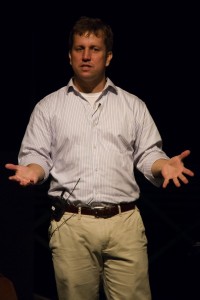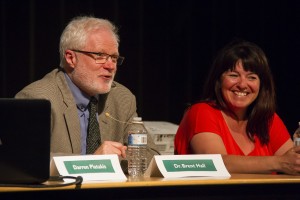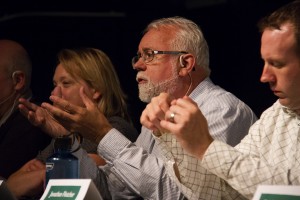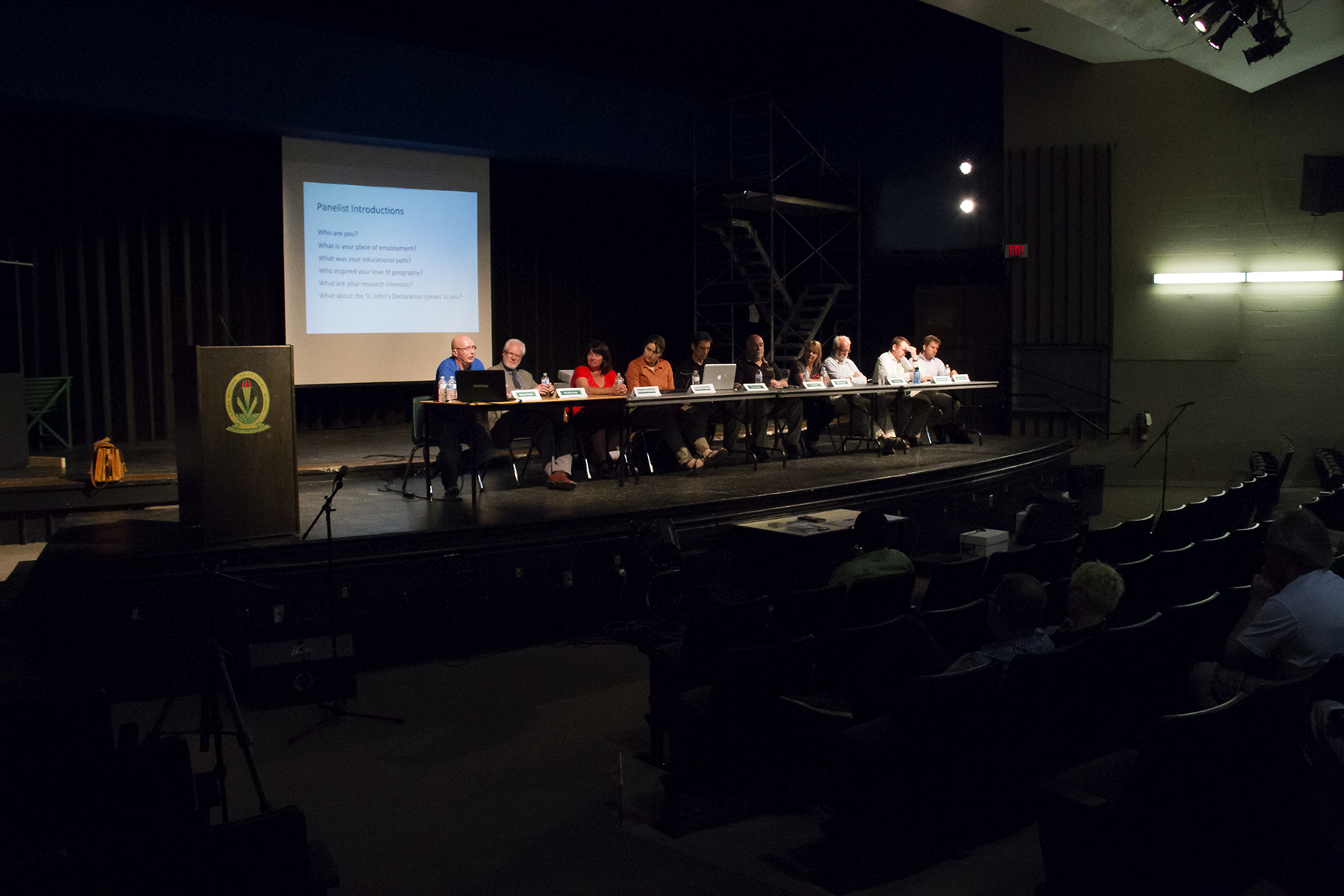CAG/CCA/ESAC Conference and Geographic Education Town Hall Recap
Having Congress 2014 of the Humanities and Social Sciences in your backyard doesn’t happen very often, and it’s a pretty big deal economically for any region that has the opportunity to host it. It seems that at this particular Congress, we were lucky enough to have a Geospatial/Environmental trifecta, having three associations of particular importance to the Geospatial community coming together: the Canadian Association of Geographers (CAG), Canadian Cartographic Association (CCA) and the Environmental Studies Association of Canada (ESAC). This might not happen again for a while – next year, CAG will be held at Simon Fraser University, while Congress 2015 will be held in Ottawa.
Town Hall Panel
Props to Brock University as a whole, but also specifically to the Geography Department and all the staff involved in organizing the poster sessions, paper sessions and of course the spectacular dinner held at Ravine Vineyards attended by members of all three organizations.
Paper and poster sessions began on Tuesday, May 27 and extended to Friday, May 30. Each day’s paper presentations ran the gamut of physical/human geography, education, GIS and Remote Sensing. Poster sessions devoted Tuesday to Physical/Environmental Geography and Climate Change, Wednesday to Human/Health Geography and Thursday to Agricultural/Rural Landscapes.
Anything I could write would be a tremendous understatement as to the quality of the presentations and the presenters. Geospatial Niagara’s focus on that first day was the Curricula Without Borders sessions as it pertains to Geographic/Geospatial education in Canada. It was incredibly inspiring and interesting to hear so many presenters talk about community engagement, experiential learning, and team-based learning. There were also discussions of the new Ontario curriculum (with the Grades 11/12 now in the works) and other efforts which use geography to build 21st century skills in students. Unfortunately, I was unable to attend the third session which seemed to be more focused on various teaching methods and the session about the St. John’s Declaration, but I needed to set up the Geospatial Niagara Geographic Education Town Hall.
Geospatial Niagara Geographic Education Town Hall
After a number of months of planning, and emails and phone calls that criss-crossed the country, the Geospatial Niagara – Geographic Education Town Hall meeting took place on Tuesday, May 27 at Laura Secord Secondary School. This event probably could not have happened if the other associated conferences had not been held in St. Catharines. The premise of the event was to promote the St. John’s Declaration, to promote geospatial technologies and information as a career (with education programs offered through both Brock University and Niagara College), and to promote Geospatial Niagara.

Dr. Gilliland
The evening began with an opening address from Dr. Jason Gilliland from the University of Western Ontario. Dr. Gilliland is the Director of “The HEAL” (Human Environment Analysis Laboratory) in London, Ontario. Both Ashley and I were fortunate enough to see his keynote address at the recent URISA Ontario BeSpatial ’14 conference in Guelph, Ontario. We were both inspired by the work he is doing, especially as it pertains to participatory geography, engaging students and citizen groups to collect data and assist them in projects that are important to them.
Overall, the event went very smoothly and I am confident that those in attendance walked away with a tremendously different view of geographic education and the realm of possibilities in the geospatial technologies and information sector. The panel was stellar and Niagara was extremely fortunate that they made themselves available to volunteer their time. Hearing the various ways that the panelists became enamoured with geography was perhaps a personal highlight for me. Everyone has a different, yet similar story of one person or event in their life where the switch was engaged.
I would personally like to thank:
Dr. Brent Hall, Dr. Marilyne Jollineau, Dr. Amanda Hooykaas, James Boxall, Ian Smith, Colleen Beard, Mark Lowry, Jonathan Fletcher and Dr. Gilliland. It was truly an honour sharing the stage with you for the Town Hall.
I would also like to thank Geospatial Niagara’s Ashley Northcotte and Trevor Jones for the photography, and current Niagara College GIS program student Olabode Olushi for helping to set up and timing the speakers. Thanks also to the student technicians and my son Declan for helping out with the sound and set-up.
Highlights included:
- A high school student who will be attending Brock University in September making a connection with Dr. Marilyne Jollineau. The student’s anxiety level immediately lowered because now there is a friendly face in the Geography Department.
- A volunteer for another non-profit discovering he could obtain ESRI software.

Dr. Brent Hall and Dr. Marilyne Jollineau
- A potential Niagara College GIS student making up his mind about entering the program.
- One young man who had his eyes glued to the stage. I know that look. It was a look of wonder and intrigue. The wheels were already turning in his mind.
- Seeing students and parents taking with them multiple copies of the St. John’s Declaration.
- The camaraderie of the panelists, despite most of them only just meeting each other.
As great as the Town Hall was, it was also very telling of the amount of work that remains to be done. My whole view in undertaking the Town Hall was that if only one student/parent came out and became inspired then it would be a success. It would all have been worth it. And it was.

Colleen Beard, Mark Lowry, Jonathan Fletcher
While I don’t have hard numbers, based on estimates, there are roughly 40,000 Grade 7-12 students across Niagara. If 1% of those students were interested in Geography/Environmental careers, that would be 400 students across the entirety of the Niagara region, plus one parent attending for a total of 800 possible attendees.
The date for the event was decided on February 27 and contacts were engaged at the boards to explain the event on an ongoing basis. Promotion through Facebook, Twitter and Eventbrite ensued. The poster for the event was sent out by the respective boards’ Communications Departments on May 1 with associated postings on their main events webpages, social media and even news media promotion.
Where it went from there is anyone’s guess. Did students actually see the poster? Did they know about the event? Herein lies the issue. My opinion is that any effort to engage students will need to happen at the classroom level, a one-on-one connection with the teacher and the students in each class. If I had the opportunity, I would have hand delivered posters to each school myself, but that was just unfeasible at this time. Granted, I’m positive that school principals (or whoever checks the email inbox at the schools) are often inundated by posters and press releases and not everything is paid attention too.
There needs to be that champion, whether they are in the class, in the school, in a city or in a region. There needs to be someone, a champion with the boots on the ground, to engage teachers and students. I throw out this challenge to friends and colleagues. The next CAG conference is at Simon Fraser University June 1-5, 2015. Someone…hold a Town Hall for local students to turn them on to a geographic education. Answer their questions, inspire them. Their story will begin that night. Years after they may be part of a panel and have your Town Hall to thank. Pay it forward.
For me, in the words of Neil Peart, it was “One Little Victory”.









